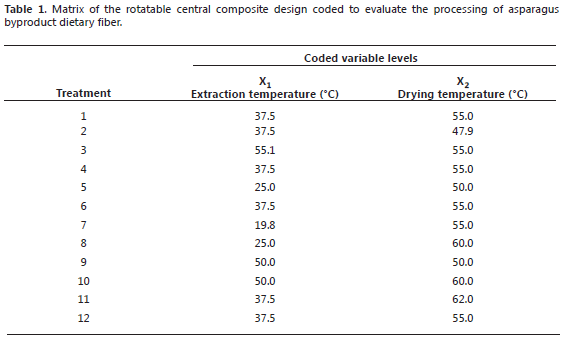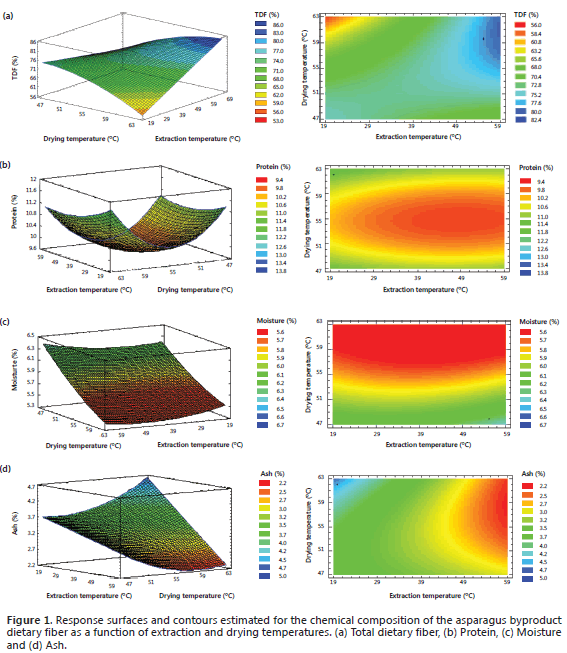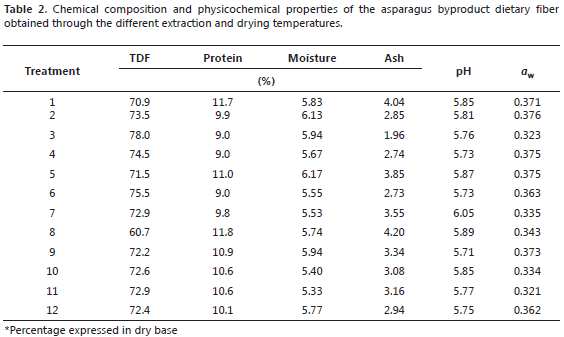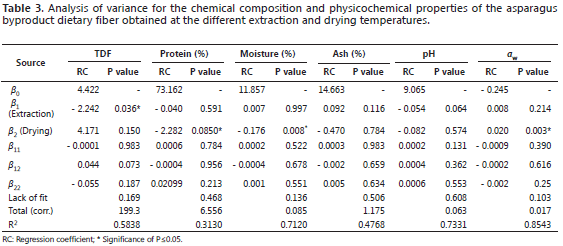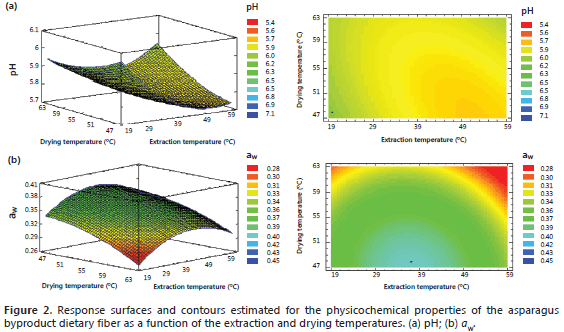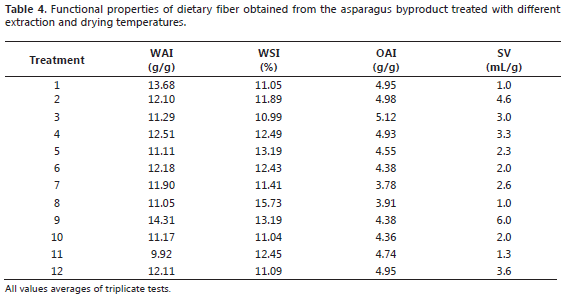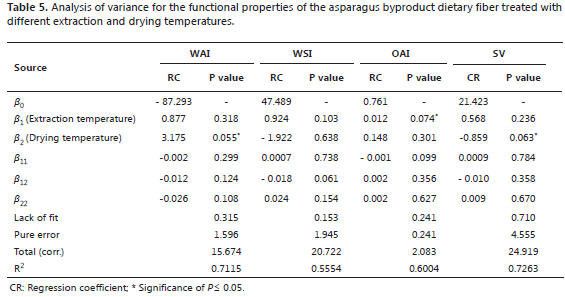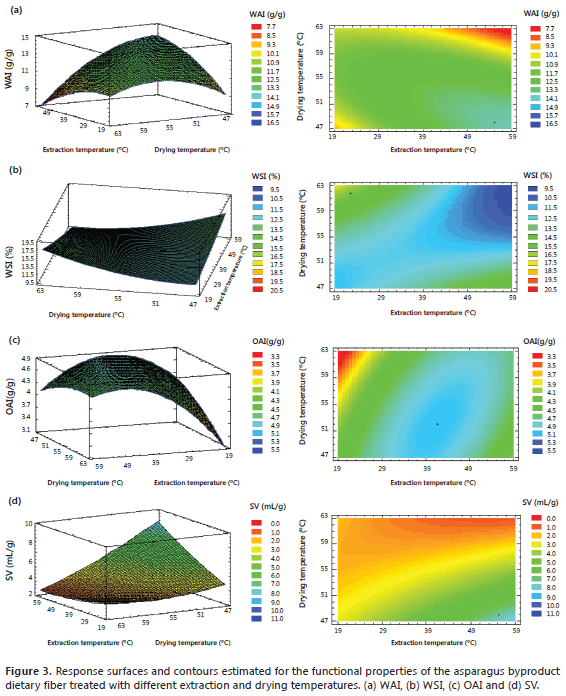Services on Demand
Journal
Article
Indicators
-
 Cited by SciELO
Cited by SciELO -
 Access statistics
Access statistics
Related links
-
 Cited by Google
Cited by Google -
 Similars in
SciELO
Similars in
SciELO -
 Similars in Google
Similars in Google
Share
Revista Facultad Nacional de Agronomía Medellín
Print version ISSN 0304-2847
Rev. Fac. Nac. Agron. Medellín vol.68 no.1 Medellín Jan./June 2015
https://doi.org/10.15446/rfnam.v68n1.47842
Chemical, Physicochemical and Functional Characteristics of Dietary Fiber Obtained from Asparagus Byproducts (Asparagus officinalis L.)
Características Químicas, Físicoquímicas y Funcionales de la Fibra Dietaria Obtenida de los Subproductos del Espárrago (Asparagus officinalis L.)
Edith Lorena Agudelo Cadavid1; Diego Alonso Restrepo Molina2 y José Régulo Cartagena Valenzuela3
1 Food Engineer. M.Sc. Consultant at Actuar Famiempresas. Medellin, Colombia. <edith79lo@yahoo.com>
2 Associate Professor. Universidad Nacional de Colombia - Sede Medellin - Facultad de Ciencias Agrarias - Departamento de Ingeniería Agrícola y Alimentos. A.A. 17779, Medellín, Colombia. <darestre@unal.edu.co>
3 Full Professor. Universidad Nacional de Colombia - Sede Medellin - Facultad de Ciencias Agrarias - Departamento de Agronomía, A.A. 1779, Medellín, Colombia. <jrcartag@unal.edu.co>
Received: March 26, 2014; Accepted: August 27, 2014.
doi: http://dx.doi.org/10.15446/rfnam.v68n1.47842
Abstract. Due to its mechanical and biochemical properties, dietary fiber is part of a healthy diet. Containing good levels of prebiotics, asparagus (Asparagus officinalis L.) produces healthy effects when incorporated into processed foods. The objective of the current study was to obtain fiber from asparagus byproducts and determine its chemical composition [Total Dietary Fiber (TDF), protein, moisture and ash)] and physicochemical [pH, and water activity (aw)] and functional characteristics [Water Absorption Index (WAI), Water Solubility Index (WSI), Oil Absorption Index (OAI) and Swelling Volume (SV)]. The plant material was treated through extraction and dehydration thermal treatments. A response surface model was applied to evaluate the effects of extraction and drying temperatures. The TDF ranged from 60.7 to 79%. Significant differences were only observed for TDF, moisture and aw (P ≤ 0.05). The WAI, WSI, OAI and SV were found to be within the range observed for similar plant materials. Due to their functional properties and elevated TDF content, asparagus byproducts can be used as active biological components in food production. This innovative utilization will contribute to reducing the environmental impact of the industrial processing of this vegetable.
Key words: Natural fiber, drying conditions, healthy food, product development.
Resumen. Por sus propiedades mecánicas y bioquímicas, la fibra dietética puede formar parte de una alimentación saludable. Al ser incorporado en los alimentos en el proceso de elaboración, el espárrago (Asparagus officinalis L.) tiene efectos benéficos para la salud del consumidor, debido a su contenido de prebióticos. El objetivo del estudio fue obtener fibra a partir de los subproductos del espárrago para determinar su composición química [Fibra Dietaria Total (FDT), proteína, humedad y cenizas] y sus propiedades físicoquímicas [pH y actividad del agua (aw)] y funcionales [Índice de Absorción del Agua (IAA), Índice de Solubilidad del Agua (ISA), Índice de Absorción de Aceite (IAAc) y Volumen de Hinchamiento (VH)]. El material vegetal se sometió a tratamientos térmicos de extracción y secado. Se ajustó un modelo de superficie de respuesta para evaluar el efecto de las temperaturas de extracción y secado. La FDT estuvo entre 60,7 y 79%. Sólo los contenidos de FDT, humedad y aw, mostraron diferencias significativas (P ≤ 0,05). Los valores de IAA, ISA, IAAc y VH estuvieron dentro de los niveles establecidos para otros materiales vegetales similares. Los subproductos del espárrago, dado su alto contenido de FDT y sus propiedades funcionales, pueden ser utilizados como elemento biológico activo en la elaboración de alimentos, contribuyendo a la reducción del impacto ambiental derivado del proceso agroindustrial de la hortaliza.
Palabras clave: Fibra natural, condiciones de secado, alimentos saludables, desarrollo de productos.
The food industry generates large amounts of solid and liquid waste products. This not only creates a contamination problem, but also the loss of valuable biomass and nutrients (Sánchez et al., 2009). These waste products are usually used as animal feed or fertilizers. Nonetheless, aspects such as environmental contamination prevention, energy saving and the need for biodegradable materials have become more and more important in recent years. For this reason, food waste treatment, management methods and policies have been introduced for the recovery, bio-conversion and utilization of valuable components found in these materials (Laufenberg et al., 2003; Tron, 2010).
The use of organic residues in the development of innovative products constitutes one of their promising possibilities. Dietary fiber (DF) can be used as an ingredient of functional foods, where it might perform as an additive with specific processing functions or final product benefits. Within a balanced diet, the combination of DF with at least one additional property can provide health benefits (Shieber et al., 2001). The demand for fruit and vegetable products as sources of DF is currently increasing due to their high nutritional quality, total and soluble fiber contents, fermentation and water retention levels, higher antioxidant capacity and lower caloric content (Rodríguez et al., 2006).
Asparagus is a healthy and nutritious vegetable and, from an economic standpoint, an important crop worldwide. In some countries, it has been used as an anti-inflammatory (Jang et al., 2004), anti-fungal (Negi et al., 2010), and anticancer medicine (Zhao et al., 2012). Asparagus stems are usually processed as canned foods, but about half the total length of each stalk is discarded, which represents an important loss for the producers. Nevertheless, these byproducts have a similar composition to that of the edible part of the plant, thus constituting a promising source of value adding new compounds (phytochemicals and fiber) (Nindo et al., 2003).
DF structure and composition are species specific, depending on cell wall components (e.g., hemicelluloses, hydrocolloidal celluloses and lignin) (Habibi, 2011) and complexity, ripening stage and the part of the plant that is used for consumption (García et al., 2008). Furthermore, DF related processes may lead to meaningful changes in vegetable structure and properties (Mongeau and Brooks, 2003; Waldron et al., 2003). Water retention capacity, particle size distribution and apparent viscosity are known to be important characteristics of DF, with significant influence on food technology. Hydration properties are important in the food industry because liquid retention influences ingredient functionalities, product yield and storage stability (Garau et al., 2006; Femenia et al., 2009).
The processing and dehydration of DF may cause irreversible modifications affecting its original structure and composition and, consequently, the final quality of the product (Garau et al., 2007; Rosell et al., 2009). In this context, the objective of the current study was to obtain DF from asparagus by-products, in order to determine its chemical composition, as well as its functional and physicochemical properties.
MATERIALS AND METHODS
Plant material. Raw material was provided by Espárragos Erupción S.A. (Manizales, Colombia). The stems were cut to obtain the upper 15 cm segment (the edible portion), while the remnant (12-15 cm spear) is considered a byproduct. Over the next 24 h, this material was preserved at 4 ºC and sent to the laboratory.
Fiber extraction. The asparagus byproduct stems were initially selected, weighed and washed for 15 min at room temperature with a 2% (v/v) detergent solution, after which they were disinfected for 10 min by immersion in a 200 ppm organic solution. Next, they were cut, homogenized and drained, and then subjected to particle size reduction in a cutting device (R302, Robot Coupe®) to obtain average sizes of 5-10 mm. Once cut, the material was homogenized with water at a 1:1 (solid: liquid) proportion (m/v) and treated at different temperatures (19.8 to 55.1 °C) for 60 min in order to extract the fiber; next the sample was centrifuged (Rotofix 32A, Hettich®). For 16 h, the resulting wet material was oven-dried (FD23, BINDER, Tuttlingen®) by forced air circulation at temperatures between 47.9 and 62.0 °C. After this period, a sample was taken to make sure the moisture was below 9% (dry base) (Santana, 2005). The obtained material was weighed with precision scales and packed in hermetically zippered polyethylene bags. This product was immediately taken to a hammer mill (Atlas®) to obtain a 0.12 to 0.25 mm particle size.
Experimental design. The Response Surface Methodology (RSM) was applied to evaluate the effects of extraction and drying temperatures (Torres et al., 2003). The experiments were randomly conducted following a Rotatable Central Composite Design with a total of 12 combinations including four repetitions of the central points and two axial points. The design matrix was coded for the extraction (X1) and drying (X2) temperatures, respectively exploring the 19.8 - 55.1 °C and the 47.9 - 62.0 °C ranges. The action of these factors on the chemical composition and physicochemical and functional properties of the studied material was assessed by applying the second grade polynomial model expressed in the equation below (Piña et al., 2006):

Where Y is the estimated response; b0, bi, bii and bij are constant coefficients of the regression model, and Xi, Xj and Xij represent the linear and quadratic effects and the interaction of the independent variables, respectively. Table 1 presents the total number of experimental runs with their corresponding temperature combination treatments. The response surface diagrams were obtained from the regression equations, keeping the response variable on the Z axis and the independent variables on the X and Y axes.
At a 0.05 significance level, an Analysis of Variance (ANOVA) was conducted to evaluate the influence of the independent variables. All analyses were conducted with the statistical software package Statgraphics Centurion XV (Version 2.15.06, Chicago, Illinois, USA). Additionally, the Lack of Fit test (LOF) (Christensen, 2003) was employed to determine whether the selected model was adequate to describe the obtained data.
Chemical and physicochemical properties
Total Dietary Fiber (TDF). The non-enzymatic gravimetric method (AOAC 993.21 - 2005) recommended for analyzing the DF in foods and food products containing 2% starch was employed. One of the duplicates was analyzed for raw protein and the other one for ash.
Protein. was measured through the Kjeldalhl method for nitrogen determination using the default protein factor of 6.25, following the AOAC 920.152 - 2005 method.
Moisture. was deduced from oven-dehydration at 103 °C, which was carried out until reaching constant weight, following the AOAC 925.45 - 2005 method.
Ash. was determined through dry-oven incineration at 550 °C, following the AOAC 942.05 - 2005 method.
pH. was measured with a Metrohm® 744 potentiometer in a mixture containing a 10 g sample of the studied material with 100 mL of deionized water.
Water activity (aw). was determined with an Aqualab® Decagon Devices Inc. 3.2 meter.
Functional properties
Water Absorption Index (WAI). One gram samples of the studied material were suspended in previously weighed 100-mL-capacity centrifuge tubes containing 25 mL of distilled water at 25 °C each. This mixture was stirred for 30 min and then centrifuged at 3,000 rpm for 10 min. The supernatant was transferred to a Petri dish of known weight and the centrifuge tube containing the pulp was weighed to determine the WAI (g of water/g of dry matter) (Fuentes et al., 2009).
Water Solubility Index (WSI). Was obtained with the same methodology employed for the WAI. The supernatant was transferred to Petri dishes, which were oven-treated for approximately 24 h (Fuentes et al., 2009).
Oil Absorption Index (OAI). Was determined under the same conditions of the WAI. The supernatant of each sample was disposed. The OAI was expressed in grams of oil/grams of dry matter (Fuentes et al., 2009).
Swelling Volume (SV). Was measured with a graduated cylinder to which 1 g of the sample was mixed with an excess of distilled water. This suspension was agitated for 30 min in order to completely hydrate the sample, then allowed to stand for approximately 24 h. The volume measured after swelling was subtracted from that initially occupied by the mixture. The value was expressed in mL g-1 of dry matter (Fuentes et al., 2009).
RESULTS AND DISCUSSION
Chemical and physicochemical properties
The largest TDF content (about 79%) was measured on those samples subjected to the 55.1 °C extraction temperature and 59.5 °C drying temperature, probably as a consequence of soluble component depletion during the process (Table 2, Figure 1a). The ANOVA (Table 3) indicates that the fiber extraction temperature determined significant differences (P≤0.05). Neither the drying temperature nor the interactions showed any significant effect on the response variable across the treatments. On the other hand, the lack of significance of the LOF test confirms that the proposed model accounts for the obtained data at a 95% confidence level. The lowest TDF count (less than 62%) was found in those samples extracted at 25 °C. The values found for this parameter in the present study, which ranged from 60.7% to 79.0%, are similar to those of Fuentes et al. (2009), and higher than the 49% record from previous analyses conducted on asparagus byproducts (Grigelmo and Martin, 1999). This contrast might be due to processing differences because the samples of the referenced research work had only been washed with water and then oven-dried. The TDF contents are usually ranked as low (30 to 50%); intermediate (50 to 70%); and high (70 to 90 %) (Jiménez et al., 2001; Figuerola et al., 2005; Rodríguez et al., 2006). The current asparagus byproduct results corresponded to the intermediate rank.
The protein content varied from 9 to 11.7%, the most important value corresponding to those samples extracted at 19.5 °C and dried at 62.0 °C (Figure 1b). The average record of this parameter was lower than that obtained in another study on the same species (Fuentes et al., 2009), but higher than that of other agribusiness byproducts such as rice bran (16%) (Abdul-Hamid and Luan, 2000). The moisture ranged from 5.33% to 6.17%. The optimum temperatures for this parameter were 47.9 °C (extraction) and 55.1 °C (drying) (Figure 1c). The ash content showed little variation among the treatments, which indicates the slight influence that the extraction and drying temperatures had on this component. Yet, the highest ash content was obtained at the 19.8 °C and 62.7 °C extraction and drying temperatures, respectively (Figure 1d). The ANOVA (Table 3) only detected significant differences (P≤0.05) for the drying temperature, whereas neither the other variation sources nor their interactions or the LOF test showed any significance. These observations support the efficacy of the proposed model. The pH ranged from 5.71 to 6.05; the most remarkable contrast being that of the 19.8 °C (extraction) and 47.9 °C (drying) temperatures (Figure 2A). The slight influence of the extraction and drying temperatures on the pH is determining for the fermentation of fiber rich substrates, which is the case of the cell walls of the studied asparagus byproduct. In effect, this material contains elevated levels of cellulose and hemicellulose, which are neutral sugar polysaccharides. The aw was lower than 0.375 at the 37.0 °C (extraction) and 47.9 °C (drying) temperatures, being the most adequate ones (Figure 2B). If aw decreases, micro-organisms with the ability to grow will also decrease. Each species of micro-organism (bacteria, yeast and mould) has its own minimum aw value below which growth is no longer possible.
Functional properties. The results obtained for the WAI, WSI, OAI and SV are shown in Table 4. The extraction and drying temperatures had no significant effects on the functional properties or the LOF test (Table 5). WAI and SV are frequently used as water retention indicators, whereas WSI is related to soluble solid levels, which are, in turn, starch degradation and denitrification indicators (Dogan and Karwe, 2003). SV refers to the fiber's volume increasing capacity in the presence of an excess of water (Villarroel et al., 2003).
The highest water absorption capacity was shown by the fiber extracted at 55.1 °C and dried at 47.9 °C (Figure 3A). From a technological and physiological standpoint, WAI is considered an important property (Fuentes et al., 2009). High temperature drying is likely to alter the physicochemical properties of the product and, consequently, its functional properties too (Femenia et al., 2000). Contrastingly, the extraction temperature is capable of modifying the structural characteristics of the fiber, which tends to facilitate water absorption (Figuerola et al., 2005). The WAI and SV are related to the porous structure of the polysaccharide chain matrix, which bears the capability of attracting and retaining water through its hydrogen bonds. The WAI values found in the present study ranged between 9.92 and 14.32 g of water/g of asparagus fiber, which is close to the counts of other species, namely peach (fruit pulp fiber: 12.6 mL of water/g) (Grigelmo and Martin, 1999) and lemon (fiber in fruit juice: 11 mL of water/g) (Lario et al., 2004). Lower values than these are usually found in cocoa shell (5 mL of water/g of fiber) (Lecumberri et al., 2007). Based on the current results, the fiber obtained from the processing of the studied asparagus byproduct can be used in the formulation of new products as a texture and viscosity modifier and, collaterally, as a calorie reducer.
The WSI of the studied asparagus byproduct ranged between 10.99% and 15.73%; the lowest count being that obtained through treatment 3 (Table 4). Additionally, the response surface model indicates that the region where the WSI was maximized corresponded to the 22.8 °C and 61.8 °C extraction and drying temperatures, respectively (Figure 3b). These WSI results broadly overcame the 4.38% to 7.0% range established for commercial corn flour, which is of common use in the human diet (Bressani et al., 2001). The WSI was influenced by the drying conditions, which may contribute to modifying texture properties, preventing syneresis (the separation of the liquid component of a gel due to contraction) and improving shelf life (Mohamed et al., 2011). Such results may have been determined by structural modifications taking place during fiber grinding, when particle size is reduced, thus exposing a larger surface area (and hence, more polar groups with water retaining sites) to the surrounding water (Rosell et al., 2009).
OAI is the maximum amount of oil (in grams) that can be retained by 1 g of dry matter immersed in an excess of oil and under the action of a force (centrifugation); it represents the capacity of the fiber to absorb oil (Tamayo and Bermúdez, 1998). In the present case, the OAI ranged between 3.58 and 5.12 g of oil/g of asparagus by-product fiber (Table 4), while its optimum count regarding the extraction and drying temperatures corresponded to 41.6 °C and 51.9 °C, respectively (Figure 3c). The current OAI values exceed those recorded for apple pomace and orange peel (0.6 - 1.8 mL g-1) by Figuerola et al. (2005), as well as unripe plantain (2 mL g-1) (Rodríguez et al., 2006), pea (1.06 -1.17 g g-1) and pigeon pea (Cajanus cajan L.) (0.96 - 0.98 g g-1) flours (Kaur et al., 2007). It is worthwhile noting that the highest OAI value observed in the current study was close to 6.0 mL g-1, which, measured in carrot pulp, is the largest record for this parameter to-date (Garau et al., 2006). These results make the studied asparagus byproduct fiber a useful ingredient to be added to foods in which emulsifying properties are needed for flavor retention, palatability improvement and useful life increases. This is particularly true in the case of baked products and cut meats, where it is important to absorb large oil amounts (Alarcón et al., 2013).
The SV of the studied asparagus by-product ranged from 1.0 mL g-1 to 6.0 mL g-1 (Table 4), the optimum record corresponded to the 55.1°C and 47.9°C extraction and drying temperatures, respectively (Figure 3d). Treatment 9 stood out for contributing the highest SV value, corresponding to the 50 °C extraction and drying temperatures, corresponding with those employed to treat orange peel in other studies that obtained similar results (Hincapié et al., 2010). Several of these SV records are within the range of many DF sources of commercial use (Valencia and Román, 2006). Finally, the differences found in the values of this parameter may explain the chemical composition of the carbohydrates found in the byproduct fiber and the temperature effects during the sample extraction and dehydration (Nawirska and Kwasniewska, 2005; Rosell et al., 2009).
CONCLUSIONS
The TDF content of the studied asparagus byproduct (60.7 - 79.0%) exhibited important functional properties - namely WAI (9.92 to 14.31 g/g), WSI (10.99 to 15.73%), OAI (3.78 to 5.12 g/g) and SV (1.3 to 6.0 mL/g) - all of which are useful in the food processing industry.
The chemical, physicochemical and functional properties of the studied asparagus byproduct make it a potential DF source, to be taken into account in the formulation of food products that are capable of satisfying the nutritional needs of the population and reducing the risk factor associated with non-traditional chronic diseases. Furthermore, this innovation may possibly contribute to a more environmentally-friendly asparagus agribusiness.
BIBLIOGRAPHY
Abdul-Hamid, A. and Y.S. Luan. 2000. Functional properties of dietary fiber prepared from defatted rice bran. Food Chemistry 68(1): 15-19. [ Links ]
Alarcón, M.A., J.H. López y D.A. Restrepo. 2013. Caracterización de la funcionalidad tecnológica de una fuente rica en fibra dietaria obtenida a partir de cáscara de plátano. Revista Facultad Nacional de Agronomía - Medellín 66(1): 6959-6968. [ Links ]
Bressani, R., J.C. Turcios, L. Reyes y R. Mérida. 2001. Caracterización física y química de harinas nistamilizadas de maíz de consumo humano en América Central. Archivos Latinoamericanos de Nutrición 51(3): 309-313. [ Links ]
Christensen, R. 2003. Chapter 8: Testing lack of fit. pp. 181-201. Unbalanced analysis of variance, design, and regression: Applied Statistical Methods. Department of Mathematics and Statistics, University of New Mexico, Albuquerque, USA. 627 p. [ Links ]
Dogan, H. and W.V. Karwe. 2003. Physicochemical properties of quinoa extrudates. Food Science and Technology International 9(2): 101-114. [ Links ]
Femenia, A., G. Sastre-Serrano, S. Simal, M.C. Garau, V.C. Eim and C. Roselló. 2009. Effects of air-drying temperature on the cell walls of kiwifruit processed at different stages of ripening. LWT-Food Science and Technology 42(1): 106-112. [ Links ]
Femenia, A., M.J. Bestard, N. Sanjuan, C. Frosselló and A. Mulet. 2000. Effect of rehydration temperature on the cell wall components of broccoli (Brassica oleracea L. v. italica) plant tissues. Journal of Food Engineering 46: 157-163. [ Links ]
Figuerola, F., M.L. Hurtado, A.M. Estévez, I. Chiffelle and F. Asenjo. 2005. Fibre concentrates from apple pomace and citrus peel as potential fibre sources for food enrichment. Food Chemistry 91(3): 395- 401. [ Links ]
Fuentes, J.M., G. Rodríguez, S. Jaramillo, J.A. Espejo, R. Rodríguez, J. Fernández, R. Guillén and A. Jiménez. 2009. Effect of extraction method on chemical composition and functional characteristics of high dietary powders obtained from asparagus by-products. Food Chemisty 113(2): 665-671. [ Links ]
Grigelmo, N. and O. Martín. 1999. Comparison of dietary fibre from by-products of processing fruits and greens and from cereals. LWT-Food Science and Technology 38(8): 503-508. [ Links ]
Garau, M.C., S. Simal, A. Femenia, C. Rosselló. 2006. Drying of orange skin: drying kinetics modeling and functional properties. Journal of Food Engineering 75(2): 288-295. [ Links ]
Garau, M.C., S. Simal, A. Femenia and C. Rosselló. 2007. Effect of air-drying temperature on physico-chemical properties of dietary fibre and antioxidant capacity of orange (Citrus aurantium v. Canoneta) by- products. Food Chemistry 104(3): 1014-1024. [ Links ]
García, O., R. Infante y C. Rivera. 2008. Hacia una definición de fibra alimentaria. Anales Venezonalos de Nutrición 21(1): 25-30. [ Links ]
Habibi, M. 2011. Date seeds: A novel and inexpensive source of dietary fiber. International Conference on Food Engineering and Biotechnology. IPCBEE. 9: 323-326. [ Links ]
Hincapié, G.A., M.N. Omaña, C.A. Hincapié, Z. Arias y L.M. Vélez. 2010. Efecto de la temperatura de secado sobre las propiedades funcionales de la fibra dietaria presente en la citropulpa. Revista Lasallista de Investigación 7(2): 85-93. [ Links ]
International Association of Official Analytical Chemists (AOAC). 2005. AOAC Method 9321. Enzymatic-gravimetric (For foods and food products. Official methods of analysis. 18 edition. AOAC International, Washington D.C. 2.500 p. [ Links ]
Jang, D., M. Cuendet, H. Fong, J. Pezzuto and A. Kinghorn. 2004. Constituents of Asparagus officinalis evaluated for inhibitory activity against cyclooxygenase-2. Journal of Agricultural and Food Chemistry 52(8): 2218-2222. [ Links ]
Jiménez, F., J. Carballo and S. Cofrades. 2001. Healthier meat and meat products: their role as functional foods. Meat Science 59(1): 5-13. [ Links ]
Kaur, M., K. Singh and N. Singh. 2007. Comparative study of the functional, thermal and pasting properties of flours from different field pea (Pisum sativum L.) and pigeon pea (Cajanus cajan L.) cultivars. Food Chemistry 104(1): 259-267. [ Links ]
Lario, Y., E. Sendra, J. García, C. Fuentes, E. Sayas, J. Fernández and J.A. Pérez. 2004. Preparation of high dietary fiber powder from lemon juice by-products. Innovative Food Science and Emerging Technologies 5(1): 113-117. [ Links ]
Laufenberg, G., B. Kunz and M. Nystroem. 2003. Transformation of vegetable waste into value added products: (A) the upgrading concept; (B) practical implementations. Bioresource Technology 87(2): 167-198. [ Links ]
Lecumberri, E., R. Mateos, M. Izquierdo, P. Rupérez, L. Goya and L. Bravo. 2007. Dietary fiber composition, antioxidant capacity and physicochemical properties of a fibre-rich product from cocoa (Theobroma cacao L.). Food Chemistry 104(3): 948-954. [ Links ]
Mohamed, E., D. Bedigian, O. Roiseux, S. Besbes, C. Blecker and H. Attia. 2011. Dietary fibre and fibre-rich by-products of food processing: Characterization, technological functionality and commercial applications: A review. Food Chemistry 124: 411-421. [ Links ]
Mongeau, R. and P.J. Brooks. 2003. Dietary Fiber. Properties and Sources. pp. 1813-1823. In: Macrae, R., R.K. Robinson and M.J. Sadler (eds). Encyclopedia of Food Sciences and Nutrition. Second edition. Academic Press, Amsterdam. 6.000 p. [ Links ]
Negi, J.S., G.P. Joshi, M.S. Rawat and V.K. Bisht. 2010. Chemical constituents of Asparagus. Pharmacognosy Reviews 4(8): 215-220. [ Links ]
Nindo, C.I., T. Sun, S.W. Wang, J. Tang and J.R. Powers. 2003. Evaluation of drying technologies for retention of physical quality and antioxidants in asparagus (Asparagus officinalis L.). LWT-Food Science and Technology 36(5): 507-516. [ Links ]
Nawirska, A. and M. Kwasniewska. 2005. Dietary fiber fractions from fruit and vegetable processing waste. Food Chemistry 91(2): 221-225. [ Links ]
Piña, M.R., M.A. Rodríguez y E.M. Benavides. 2006. Metodología robusta para superficies de respuestas. Revista Científica y Tecnológica 3(12): 32-46. [ Links ]
Rodríguez, R., A. Jiménez, J. Fernández, R. Guillén and A. Heredia. 2006. Dietary fibre from vegetable products as source of functional ingredients. Trends Food Science and Technology 17(1): 3-15. [ Links ]
Rosell, C.M., E. Santos and C. Collar. 2009. Physico-chemical properties of commercial fibres from different sources: A comparative approach. Food Research International 42(1): 176-184. [ Links ]
Sánchez, R., M.V. Najul, E. Ortega y G. Ferrara de Giner. 2009. El manejo de los residuos en la industria de agroalimentos en Venezuela. Interciencia 34(2): 91-99. [ Links ]
Santana, M. 2005. Characterization physicochemical of fiber dietary from orange and passion fruit. Ph.D. Dissertation (Doctor Food Engineering]. Faculdade de Engenharia de Alimentos. Universidade Estadual de Campinas, Sao Paulo. 188 p. [ Links ]
Shieber, A., C. Stintzing and R. Carle. 2001. By-products of plant food processing as a source of functional compounds - recent developments. Trends in Food Science and Technology 12(11): 401-413. [ Links ]
Tamayo, Y. y A.S. Bermúdez. 1998. Los residuos vegetales de la industria de jugo de naranja como fuente de fibra dietética. pp. 181-189. En: Lajolo, F. and E. Wenzel (eds.). Temas de Tecnología de alimentos, fibra dietética Volumen 2. Fibra Dietética. CYTED. Instituto Politécnico Nacional, México. 288 p. [ Links ]
Tron, F. 2010. La recogida de basura en Mega-ciudades: En el marco de la sostenibilidad. Revista INVI 25(70): 181-222. [ Links ]
Torres, R., F. Chacin, J. García and M. Ascencio. 2003. Optimización en modelos de superficies de respuesta. Revista Facultad Agronomía (Maracay) 29: 69-83. [ Links ]
Valencia, F.E. y M.O. Román. 2006. Caracterización fisicoquímica y funcional de tres concentrados comerciales de fibra dietaria. Vitae 13(2): 54-60. [ Links ]
Villarroel, M., C. Acevedo, E. Yañez y E. Biolley. 2003. Propiedades funcionales de la fibra del musgo Sphagnum magellanicum y su utilización en la formulación de productos de panadería. Archivos Latinoamericanos de Nutrición 53(4): 400-407. [ Links ]
Waldron, R.W., M.L. Parker and A.C. Smith. 2003. Plant cell walls and food quality. Comprehensive Reviews in Food Science and Food Safety 2(4): 128-146. [ Links ]
Zhao, Q., B. Xie, J. Yan, F. Zhao, J. Xiao, L. Yao, B. Zhao and Y. Huang. 2012. In vitro antioxidant and antitumor activities of polysaccharides extracted from Asparagus officinalis. Carbohydrate Polymers 87(1): 392-396. [ Links ]













